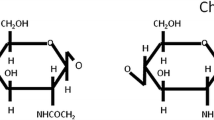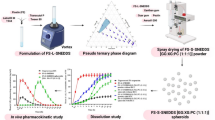Abstract
In the present study, isolated soy protein/sodium alginate (ISP/SA) nanoparticles were fabricated for the target delivery of curcumin. Response surface method of box-Benken design was used to evaluate the effects of ISP (1.0–4.0% (w/v)), SA (0.03–0.07% (w/v)) and CaCl2 (0.003–0.01% (w/v)) concentration on physicochemical properties of ISP/SA nanoparticles, and selection of optimum nanoparticles. The results showed that the soluble complex of ISP/SA was occurred at pH = 5.8. The optimum concentrations of ISP, SA, and CaCl2 for the creation of ISP/SA nanoparticle were 1.6% (w/v), 0.069% (w/v), and 0.008% (w/v), respectively. The optimum nanoparticle had a stable dispersion with the zeta potential, %EE, %LC and particle size of −46.5 mV, 99.86%, 0.60%, and 120 nm, respectively. Atomic force microscope images confirmed the formation of spherical particles with a smooth surface. In simulated intestinal conditions, 25% release of curcumin from ISP/SA nanoparticles was reported. The kinetics of curcumin release was consistent with the Peppas model, based on the mechanism of erosion and diffusion. Curcumin-loaded ISP/SA nanoparticles had more thermal stability than curcumin-free (p˂0.05).
Graphical abstract












Similar content being viewed by others
Data availability
All data generated or analyzed during this study are available from the corresponding author on reasonable request.
References
A.V. Kabanov, S.V. Vinogradov, Nanogels as pharmaceutical carriers: finite networks of infinite capabilities. Angew. Chem. Int. Ed. 48(30), 5418–5429 (2009)
B. Jin et al., Self-assembled modified soy protein/dextran nanogel induced by ultrasonication as a delivery vehicle for riboflavin. Molecules 21(3), 282 (2016)
M. Khoshmanzar et al., Investigation of effective parameters on particle size, zeta potential and steady rheological properties of colloidal system based on carrageenan-caseinate nanoparticles. Res. Innov. Food Sci. Technol. 1(4), 255–272 (2013)
F. Zhao et al., Composites of polymer hydrogels and nanoparticulate systems for biomedical and pharmaceutical applications. Nanomaterials 5(4), 2054–2130 (2015)
D.P. Jaramillo, R.F. Roberts, J.N. Coupland, Effect of pH on the properties of soy protein–pectin complexes. Food Res. Int. 44(4), 911–916 (2011)
A. Dodero et al., Rheological properties of sodium alginate solutions in the presence of added salt: an application of Kulicke equation. Rheol. Acta (2020). https://doi.org/10.1007/s00397-020-01206-8
K. Yao et al., Tailoring zein nanoparticle functionality using biopolymer coatings: impact on curcumin bioaccessibility and antioxidant capacity under simulated gastrointestinal conditions. Food Hydrocoll. 79, 262–272 (2018)
S. Naji-Tabasi et al., Investigation of oleogel properties prepared by pickering emulsion-templated stabilized with solid particles of basil seed gum and isolated soy protein as a fat substitute in cream. Res. Innov. Food Sci. Technol. 9(3), 267–280 (2020)
F.-P. Chen, B.-S. Li, C.-H. Tang, Nanocomplexation of soy protein isolate with curcumin: influence of ultrasonic treatment. Food Res. Int. 75, 157–165 (2015)
J. Zhang et al., Preparation and in vitro evaluation of calcium-induced soy protein isolate nanoparticles and their formation mechanism study. Food Chem. 133(2), 390–399 (2012)
S. Naji-Tabasi et al., Nanoparticles fabrication of soy protein isolate and basil seed gum (Ocimum bacilicum L.) complex as pickering stabilizers in emulsions. J Dispers. Sci. Technol. (2019). https://doi.org/10.1080/01932691.2019.1703736
B. Sarmento et al., Insulin-loaded nanoparticles are prepared by alginate ionotropic pre-gelation followed by chitosan polyelectrolyte complexation. J. Nanosci. Nanotechnol. 7(8), 2833–2841 (2007)
F. Sarei et al., Alginate nanoparticles as a promising adjuvant and vaccine delivery system. Indian J. Pharm. Sci. 75(4), 442 (2013)
P. Sarika, N.R. James, D.K. Raj, Preparation, characterization and biological evaluation of curcumin loaded alginate aldehyde–gelatin nanogels. Mater. Sci. Eng., C 68, 251–257 (2016)
R. Ahdyani et al., Formulation and characterization of timolol maleate-loaded nanoparticles gel by ionic gelation method using chitosan and sodium alginate. Int. J. Appl. Pharm 11, 48–54 (2019)
C.L. Wu et al., Formation and characterisation of food protein–polysaccharide thermal complex particles: effects of pH, temperature and polysaccharide type. Int. J. Food Sci. Technol. 55(3), 1368–1374 (2020)
L. Dai et al., Structural characterization, formation mechanism and stability of curcumin in zein-lecithin composite nanoparticles fabricated by antisolvent co-precipitation. Food Chem. 237, 1163–1171 (2017)
L. Wang et al., Nanoparticles prepared by proso millet protein as novel curcumin delivery system. Food Chem. 240, 1039–1046 (2018)
S. Sheikhzadeh et al., Nanoencapsulation of curcumin by sodium caseinate and gum Arabic. Agro Food Ind Hi Tech 26(6), 49–52 (2015)
M.L.F. Freitas, K.M. Albano, V.R.N. Telis, Characterization of biopolymers and soy protein isolate-high-methoxyl pectin complex. Polímeros 27, 62–67 (2017)
S. Naji-Tabasi, S.M.A. Razavi, H. Mehditabar, Fabrication of basil seed gum nanoparticles as a novel oral delivery system of glutathione. Carbohyd. Polym. 157, 1703–1713 (2017)
S. Naji-Tabasi et al., Nanoparticles fabrication of soy protein isolate and basil seed gum (Ocimum bacilicum L.) complex as pickering stabilizers in emulsions. J. Dispers. Sci. Technol. 42(5), 633–640 (2021)
S. Shahbazizadeh et al., Development of Cress Seed Gum Hydrogel and Investigation of its Potential Application in the Delivery of Curcumin. J. Sci. Food Agric. 101(15), 6505–6513 (2021)
S. Solghi et al., The encapsulation of curcumin by whey protein: assessment of the stability and bioactivity. J. Food Process Eng. 43(6), e13403 (2020)
X. Kong et al., Characteristics of soy protein isolate/gum arabic-stabilized oil-in-water emulsions: influence of different preparation routes and pH. RSC Adv. 7(51), 31875–31885 (2017)
N. Chen et al., Stable and pH-sensitive protein nanogels made by self-assembly of heat denatured soy protein. J. Agric. Food Chem. 62(39), 9553–9561 (2014)
C. Liu et al., Elaboration of curcumin-loaded rice bran albumin nanoparticles formulation with increased in vitro bioactivity and in vivo bioavailability. Food Hydrocoll. 77, 834–842 (2018)
H. Mirhosseini et al., Effect of Arabic gum, xanthan gum and orange oil contents on ζ-potential, conductivity, stability, size index and pH of orange beverage emulsion. Colloids Surf., A 315(1–3), 47–56 (2008)
B. Gh, Gum arabic-caseinate nanocomplexes bearing β-carotene (2): studying of particle size distribution, zeta potential, morphology and encapsulation efficiency. J. Food Res. 26(4), 763–778 (2017)
S. Khalloufi et al., Flaxseed gums and their adsorption on whey protein-stabilized oil-in-water emulsions. Food Hydrocoll. 23(3), 611–618 (2009)
M.G. Carneiro-da-Cunha et al., Influence of concentration, ionic strength and pH on zeta potential and mean hydrodynamic diameter of edible polysaccharide solutions envisaged for multinanolayered films production. Carbohyd. Polym. 85(3), 522–528 (2011)
G.-Q. Huang et al., Complex coacervation of soybean protein isolate and chitosan. Food Chem. 135(2), 534–539 (2012)
H. Daemi, M. Barikani, Synthesis and characterization of calcium alginate nanoparticles, sodium homopolymannuronate salt and its calcium nanoparticles. Scientia Iranica 19(6), 2023–2028 (2012)
H. Daemi, M. Barikani, M. Barmar, Variations in calcium and alginate ions concentration in relation to the properties of calcium alginate nanoparticles. Sci. Technol. 26(1), 25–32 (2013)
C. Liu, F. Cheng, X. Yang, Fabrication of a soybean bowman–birk inhibitor (bbi) nanodelivery carrier to improve bioavailability of curcumin. J. Agric. Food Chem. 65(11), 2426–2434 (2017)
L. Zhang et al., Alginate-shelled SPI nanoparticle for encapsulation of resveratrol with enhanced colloidal and chemical stability. Food Hydrocoll. 90, 313–320 (2019)
Z. Teng, Y. Luo, Q. Wang, Nanoparticles synthesized from soy protein: preparation, characterization, and application for nutraceutical encapsulation. J. Agric. Food Chem. 60(10), 2712–2720 (2012)
A. Tapal, P.K. Tiku, Complexation of curcumin with soy protein isolate and its implications on solubility and stability of curcumin. Food Chem. 130(4), 960–965 (2012)
E. Çelik et al., The effect of calcium chloride concentration on alginate/Fmoc-diphenylalanine hydrogel networks. Mater. Sci. Eng., C 66, 221–229 (2016)
Q. Cheng et al., Dual cross-linked hydrogels with injectable, self-healing, and antibacterial properties based on the chemical and physical cross-linking. Biomacromol 22(4), 1685–1694 (2021)
S. Peng et al., Utilization of biopolymers to stabilize curcumin nanoparticles prepared by the pH-shift method: caseinate, whey protein, soy protein and gum Arabic. Food Hydrocoll. 107, 105963 (2020)
L.K. Voon, S.C. Pang, S.F. Chin, Optimizing delivery characteristics of curcumin as a model drug via tailoring mean diameter ranges of cellulose beads. Int. J. Polymer Sci. (2017). https://doi.org/10.1155/2017/2581767
J.D.P. Soares, J.E. Santos, G.O. Chierice, E.T.G. Cavalheiro, Thermal behavior of alginic acid and its sodium salt. Eclética Química. 29(2), 57–64 (2004)
L. Chen et al., Soy protein isolate-carboxymethyl cellulose conjugates with pH sensitivity for sustained avermectin release. R. Soc. Open Sci. 6(7), 190685 (2019)
I.M. Fareez et al., Chitosan coated alginate–xanthan gum bead enhanced pH and thermotolerance of Lactobacillus plantarum LAB12. Int. J. Biol. Macromol. 72, 1419–1428 (2015)
A.K. Dewangan, S. Varkey, S. Mazumder, Synthesis of curcumin loaded CMCAB nanoparticles for treatment of rheumatoid arthritis (International conference on chemical. environmental and biological sciences, CEBS Dubai, 2015)
H. Shoukat et al., Development of β-cyclodextrin/polyvinypyrrolidone-co-poly (2-acrylamide-2-methylpropane sulphonic acid) hybrid nanogels as nano-drug delivery carriers to enhance the solubility of rosuvastatin: an in vitro and in vivo evaluation. PLoS ONE 17(1), e0263026 (2022)
K.M. Rao et al., Synthesis and characterization of biodegradable Poly (Vinyl caprolactam) grafted on to sodium alginate and its microgels for controlled release studies of an anticancer drug. J. Appl. Pharm. Sci. 3(6), 61–69 (2013)
W. Gao et al., Nanoparticle-hydrogel: a hybrid biomaterial system for localized drug delivery. Ann. Biomed. Eng. 44(6), 2049–2061 (2016)
C.M. Talbott, S. Au-NP, Spectroscopic Characterization of Nanoparticles for Potential Drug Discovery. Application News (2014)
P. Li et al., Chitosan-alginate nanoparticles as a novel drug delivery system for nifedipine. Int. J. Biomed. Sci. 4(3), 221 (2008)
P.K. Mohan et al., Water soluble complexes of curcumin with cyclodextrins: characterization by FT-Raman spectroscopy. Vib. Spectrosc. 62, 77–84 (2012)
O.S. Reddy et al., Curcumin encapsulated dual cross linked sodium alginate/montmorillonite polymeric composite beads for controlled drug delivery. J. Pharm. Anal. 11(2), 191–199 (2021)
L. Pathak, A. Kanwal, Y. Agrawal, Curcumin loaded self assembled lipid-biopolymer nanoparticles for functional food applications. J. Food Sci. Technol. 52(10), 6143–6156 (2015)
N.T. Nguyen et al., Curcuminoid co-loading platinum heparin-poloxamer p403 nanogel increasing effectiveness in antitumor activity. Gels 8(1), 59 (2022)
I.R. Ariyarathna, D.N. Karunaratne, Microencapsulation stabilizes curcumin for efficient delivery in food applications. Food Packag. Shelf Life 10, 79–86 (2016)
F.-P. Chen, B.-S. Li, C.-H. Tang, Nanocomplexation between curcumin and soy protein isolate: influence on curcumin stability/bioaccessibility and in vitro protein digestibility. J. Agric. Food Chem. 63(13), 3559–3569 (2015)
C. Pornpitchanarong et al., Curcumin-incorporated thiolated chitosan/alginate nanocarriers: physicochemical properties and release mechanism. Indian J. Pharm. Sci. 82(1), 101–108 (2020)
M. Mohammadian et al., Enhancing the aqueous solubility of curcumin at acidic condition through the complexation with whey protein nanofibrils. Food Hydrocoll. 87, 902–914 (2019)
Acknowledgements
The authors are thankful to the laboratories of the Research Institute of Food Science and Technology, Mashhad, Iran for their support to conduct the research work.
Funding
No funding.
Author information
Authors and Affiliations
Contributions
SS: Data curation, formal analysis, investigation, methodology, writing— original draft. SNT: conceptualisation, supervision, project administration, review and editing, validation. MSN: supervision, review and editing, conceptualisation, validation. All authors read and approved the final manuscript.
Corresponding author
Ethics declarations
Conflict of interest
The authors declare that they do not have any conflict of interest.
Ethical approval
This study does not involve any human or animal testing.
Additional information
Publisher's Note
Springer Nature remains neutral with regard to jurisdictional claims in published maps and institutional affiliations.
Rights and permissions
Springer Nature or its licensor holds exclusive rights to this article under a publishing agreement with the author(s) or other rightsholder(s); author self-archiving of the accepted manuscript version of this article is solely governed by the terms of such publishing agreement and applicable law.
About this article
Cite this article
Shahbazizadeh, S., Naji-Tabasi, S. & Shahidi-Noghabi, M. Entrapment of curcumin in isolated soy protein-alginate nanogels: antioxidant stability and in vitro gastrointestinal digestion. Food Measure 16, 4754–4770 (2022). https://doi.org/10.1007/s11694-022-01562-4
Received:
Accepted:
Published:
Issue Date:
DOI: https://doi.org/10.1007/s11694-022-01562-4




